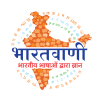Languages
भारतवाणी
bharatavani
bharatavani

Knowledge through Indian Languages



